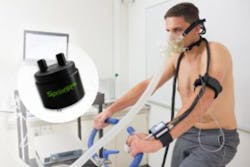Cumbernauld, UK. Gas Sensing Solutions (GSS) Ltd, which specializes in LED-based NDIR (nondispersive infrared) detectors, has launched its new SprintIR6S. The company says its SmartIR technology enables the new sensor to take up to 20 CO2 readings per second—a six-times-faster response rate than the current SprintIR*.
Ralph Weir, GSS CEO, said, “We are the only company producing CO2 sensors using LEDs and photodiodes and, as we make the LEDs and photodiodes ourselves, we have been able to develop ultrafast response times that no other NDIR sensor can match. Typical NDIR CO2 detectors take several seconds or even minutes to take a reading—because they use slow-reacting IR sources, which need time and energy to warm up, like MEMS hotplates, micro-bulbs, or filament-based micro-lamp technologies. Our LEDs, by contrast, are solid-state emitters and illuminate almost instantly. With the new SprintIR6S, we’ve also minimized the sample volume down to only 2 ml, which enables us to achieve our fastest ever response rates*. This puts us in a unique position to open whole new application areas for CO2 monitors that could never be addressed by slow responding sensors based on traditional IR sources.”Applications for this new class of ultra-fast CO2 sensors include health where they can capture rapidly changing CO2 concentrations in the breathing cycle to provide diagnostic information, which can be used in fitness testing, breath analysis/measurement, capnography, sports science, and veterinary medicine to name a few. In industrial health and safety applications, such as factories where CO2 is used for modified atmospheres to delay packaged food from spoiling, they can provide ultra-fast detection of rising CO2 levels. Even a doubling or tripling of normal CO2 levels can affect concentration and productivity with higher levels having increasingly deleterious effects on health right up to unconsciousness and death.
“A leak from a CO2 canister or similar can push CO2 levels up from the normal 400 ppm to several thousand ppm in seconds,” added Weir. “You cannot smell CO2 and it is colorless. Yet it can present serious health problems at raised concentrations so, the sooner an alarm is raised, the sooner people can take remedial action. For example, restaurants and pubs usually have CO2 cylinders in the basement for the drinks but basements typically have poor ventilation so an undetected CO2 leak could suddenly raise the CO2 level when someone was in the basement and render them unconscious—or dead. Our new sensors can give the earliest possible warning.”
GSS’ multi-patented SmartIR technology detects the presence of CO2 by detecting how much light is absorbed by CO2 molecules as light passes through the sample gases. CO2 absorbs between 4.2 and 4.4 microns so that its presence is easily detected, and the amount of light absorbed indicates how much CO2 is present. Typically, CO2 detectors use a miniature heater (such as MEMS devices like micro hotplates, micro-lamp/micro-bulb or filament heater) to generate a range of wavelengths that have to be filtered down to the wavelengths needed, which is wasteful and energy inefficient, especially as a lot of heat is produced. By contrast, GSS developed commercial, mid-range IR LEDs that are specifically tuned to emit just at 4.2 to 4.4 microns, making them energy-efficient. A single lithium cell can power a SmartIR sensor for up to ten years.
At less than a cubic inch (23.8 mm in diameter and 24 mm tall), the SprintIR6S operates at between 3.25 and 5.5 V, with a power consumption of only 35 mW. The SprintIR6S is available in measurement ranges from 0% to 100%.
GSS will be revealing the new SprintIR6S detectors at the Sensor + Test show in Nuremberg, Germany, from May 30 to June 1, 2017. SprintIR6S evaluation kits and products can be ordered from June 2017.
*Based on 0.1 liter-per-minute flow rate and 0 to 10% step change in CO2 concentration.
About the Author

Rick Nelson
Contributing Editor
Rick is currently Contributing Technical Editor. He was Executive Editor for EE in 2011-2018. Previously he served on several publications, including EDN and Vision Systems Design, and has received awards for signed editorials from the American Society of Business Publication Editors. He began as a design engineer at General Electric and Litton Industries and earned a BSEE degree from Penn State.

